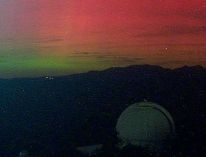 Lately, I’ve been studying solar phenomena because I think the topic is so critical to understanding the natural processes that affect global weather and climate. An interesting segué from the weather aspect, however, is into the subject of auroras – Aurora Borealis in the North and Aurora Australis in the South. What causes them?
Lately, I’ve been studying solar phenomena because I think the topic is so critical to understanding the natural processes that affect global weather and climate. An interesting segué from the weather aspect, however, is into the subject of auroras – Aurora Borealis in the North and Aurora Australis in the South. What causes them?
Occasionally, we see auroras in Southern California, but it’s an extremely rare sight. The last auroral display I can remember seeing was way back in 1962, although other people have seen them several times since then. The UCLA webcam on Mount Wilson near Los Angeles recorded the image to the right on March 30, 2001.
Anyhow, back to the topic of what causes these elusive Rainbow Curtains — from SOHO and NASA — Space Weather:
Sunspots show us where the Sun’s magnetic fields are most intense. Magnetic fields above sunspots act like invisible nets, blocking the escape of electrically charged gas, or plasma, that constantly boils away from the solar surface. When the pressure is too great, they burst. Solar storms then erupt with the power of millions of Hydrogen bombs!
If the explosion occurs low in the solar atmosphere, the blast is short but intense. It pours out ultraviolet light, x-rays and energetic particle radiation – a solar flare. If the magnetic “nets” stretch far into the corona before they break, we have a Coronal Mass Ejection (CME), a billion tons of solar plasma speeding at over a million miles per hour!
Two to four days later, if the storm is aimed at Earth, the results can be dramatic. Induced currents can corrode pipelines, destroy power grids, and cause blackouts. Navigation and communication satellites can be damaged. Astronauts may be exposed to high radiation doses.
The most beautiful effects of Earth-directed solar storms are aurora – shimmering curtains and swirls of light in the night sky. Some solar particles find their way into Earth’s protective magnetosphere. Most gather on the far side in the “magnetotail.†Then, sped by a magnetic slingshot (bright flash in the animation), the re-energized particles zoom in along Earth’s magnetic fields and strike the upper atmosphere in ovals around the poles where atoms glow like neon lights.
This NASA animation nicely allows us to visualize the Coronal Mass Ejection and the terrestrial magnetosphere ionization process described in that last paragraph above:
Although the exact process seen in the animation is not completely understood, project THEMIS intends to answer the last of our questions and resolve ambiguities surrounding the Rainbow Curtains.
